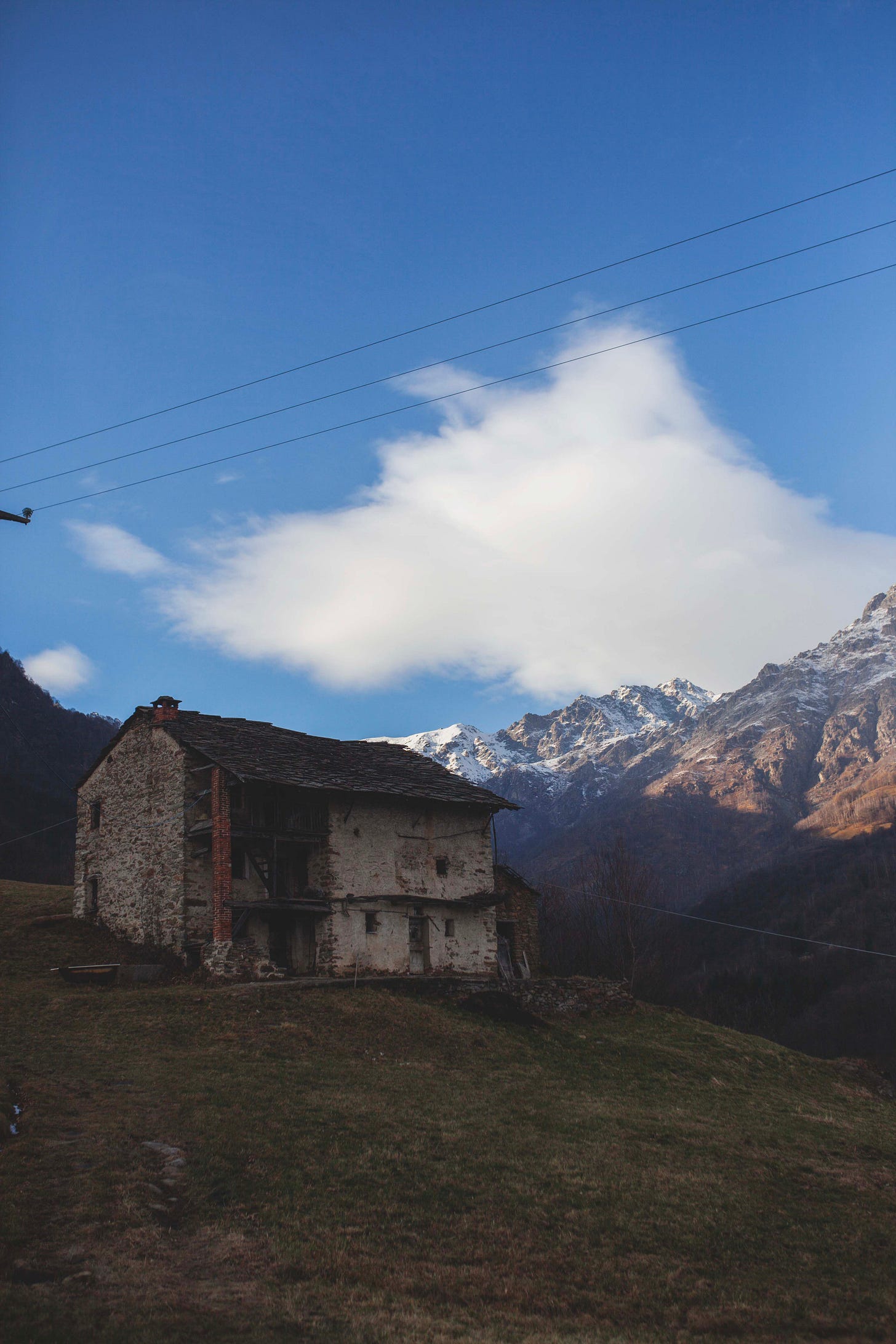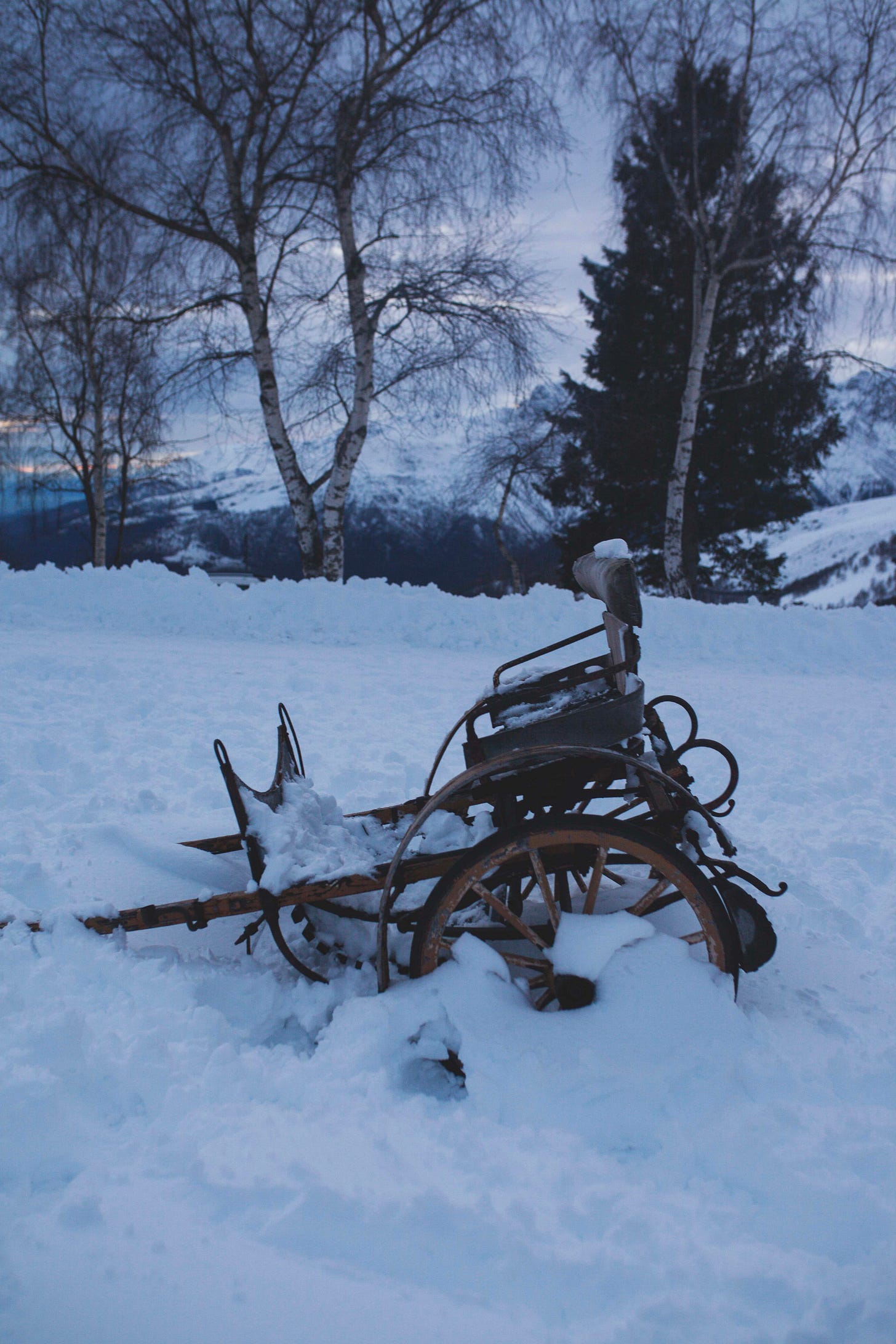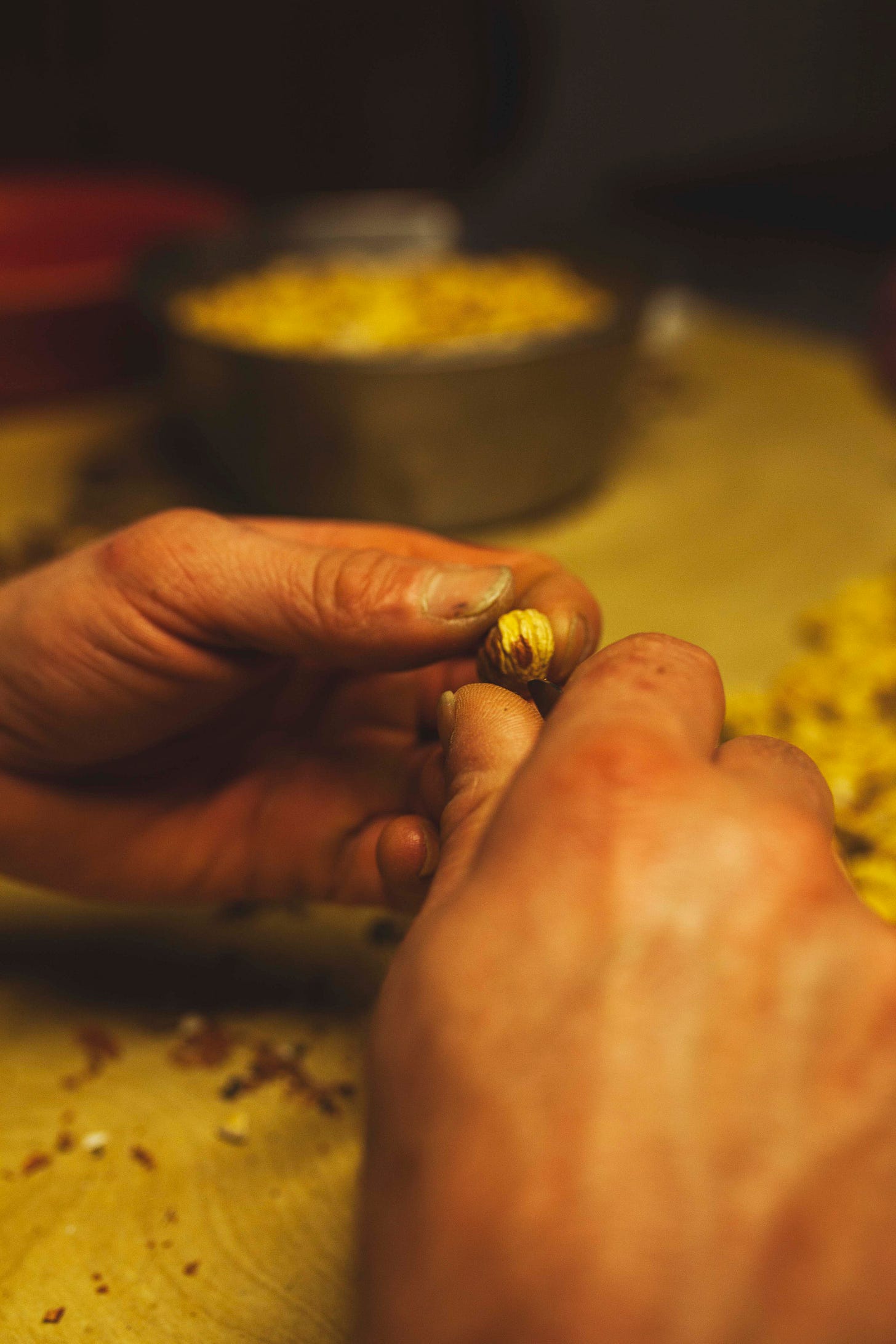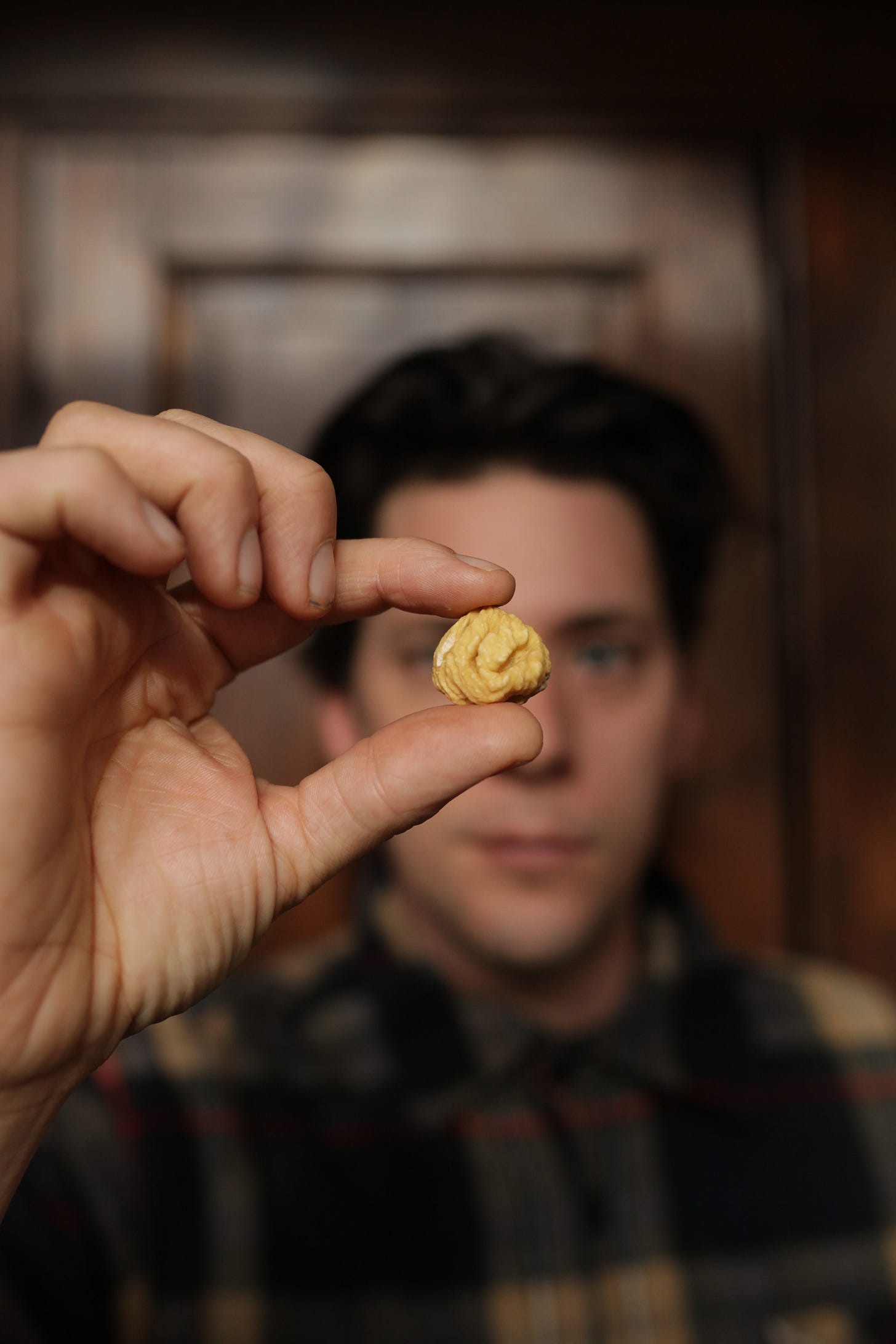part three EATING CAT, RABBIT, HORSE AND ILLEGAL BUTTER // In Defence Of The Mountain
How the secret pre-alpine tradition of eating cats feeds my changing world-view.
In this third and final part of “In Defence of the Mountain”, I discover alpine traditions that make me see how the world is upside down. It’s not just about how we engage with our food, but rather how we’re looking at a need to rewire our brains, by looking at what’s above us.
If you would like to read more about the tradition of chestnut smoking that features in this piece, I recommend reading this article for more context.
Names have been omitted out of respect for the alpigiani.
The findings of this recent trip have lead to a project that is in the works to explore more of the alpigiano traditions this summer, when the deeper parts of the mountains above Biella will (hopefully) be occupied by those who still uphold this disappearing mountain ways, and I shall be looking for the higher dwellings of the “second transhumance”, which is explained in this piece.
Paid subscribers get my captioned photography as well as some private and challenging images behind the alpigiano traditions of eating rabbits (highly recommend).
Paid subscribers are turning this project into something tremendously exciting. Please consider upgrading to paid and become part of the project, it is just so unbelievably brilliant and facilitates the research for this archive. Or share with someone who might be happy to patronise this project!
Thanks!
IN DEFENCE OF THE MOUNTAIN
Part Three
Max Jones
We arrived at the dwelling further down the mountain and opened the door onto the timeless scene of T, a woman in her late seventies, sat with her back to the fire next to jute sackfuls of chestnuts. We sat round her table and got down to the task of processing them into different piles so I could take some home.
We settled in with more coffee and grappa, chattering about food and the value of provenance and I told them about the talk I gave in the retirement home a few days earlier, hoping to connect some dots between the alpigiani artisans of the mountains above the people of Biella and the retirement home below.
With a little care and feigned indifference, I retold that “one gent mentioned how they used to eat cats too, can you believe it?'“ and I left it hanging.
For a while, the only sound was the crackle of the fire and the scratching of knives scraping the rock-hard chestnuts, digging out scraps of dried, furry skin that clung to its crevices. They glanced at each other, poker-faced T shuffling in her seat and D cocking his head to its side, lips inwardly pursed and his eyebrows raised very high indeed.
“Cats?” she asked, “Pffffft”
We continued scratching away in a brief silence with more glances between them until T’s frowning mouth curled into a grin and she slammed her hands to the table leaning towards me, sending a few chestnuts tumbling onto the floor-
“They’re delicious!”
It was absolutely brilliant to realise they felt safe to speak with me, after the various pilgrimages I had made to their spot of the mountain over the last two years. We had reached the great milestone of trust, which is difficult with the Biellese as my Zio Sandro used to say, let alone the alpigiani.
I asked about what I had heard as a child, about how I thought it happened during the War when meat was rationed and food was scarce, with the stories of burying them in the snow for a week before eating them. And then I took stock of my situation. There we were, huddled round a table in a tiny room of an ancient stone house. The walk from where D lived above had been over frozen earth that crunched as we climbed down. The shape of the building began to make sense- how the small rooms could heat up much more quickly, requiring less wood to burn and the tiny windows would keep in the heat. The huge, rough stone slabs that tiled the roof could bear mighty drifts of snow, even designed to hold it in place for added insulation. It was fascinating to observe how the even the architecture was congruent with mountain life and survival.
There was a thick evening frost outside that fell fast on the dwellings as the evening’s purple light faded earlier than expected, swallowed in the cold shadow of the mountains so close either side. And within, sat in the little oven room round the table with fire aglow, we were working through sackfuls of chestnuts from the trees that surrounded them, desiccated with smoke from the smouldering husks of the previous year’s chestnuts, in a smoker made of the mountain. All this to provide food to get through the winter, and a lived tradition that spans thousands of years- this is how every evening was spent through every winter as far back as anyone cares to remember. The cumulative gain of a monotonous task, with the piles getting higher over hearty chatter. I’m looking at a jar of the chestnuts right now as I write - I love to think about the conversations they might have heard in that tiny room on the mountain, and how they were handled so deftly in that mountain dwelling. To eat them will be to nourish myself with stories, and to become their landscape. There is little else that can offer me such meaning.
T leant back in her chair and folded her glasses, sticking them upright in a bowl of chestnuts.
“A while ago, when the winters were colder you would feel a craving for meat. And if you were stuck and couldn’t travel to Sordevolo, or mainly because of a lack of this”,
she turned her old fingers upward and rubbed them together signifying money-
“then you would take a cat if you were lucky enough for one to pass you by now and again. You’d wait until it got close enough, then grab its head and pull, just like a rabbit. Then you’d gut it and skin it and tie it to a rock in the icy stream to age for a few days. It would turn into a giant ice cube! This purified the meat, making it white and very tender. And if you didn’t have a stream nearby, you would soak it in spring water and hang it up outside to freeze in the February wind for a few days and it would have the same effect.”
“How would you cook it?”
“Hmmmm, lovely, just like rabbit. Fried in a pan with butter or lardo and rosemary and serve it with a little polenta or some of these.”
She smiled and pulled her glasses back out of the bowl.
“Have you got a bag? It’s getting late and dark and you must get back down to your little girl!”
With a paper bag full of what I had come for, I said my goodbyes. As I opened the door to leave, a red and white cat scurried into the room. It must have been leaning against the warm draft that escaped from beneath the old chestnut-wood door throughout the whole conversation. I burst out laughing in disbelief, pointing as it leapt onto the table and into T’s lap.
“But… but…”
“No, no, no, are you mad? Not this one, this one’s mine! What are you like!?”
She gave me a wink and I closed the door to the warm fire-lit room, stepping out into the cold and blue night, heading down to the twinkling lights of the city below.

With renewed excitement at my findings on the mountain, I gave more energy to researching meat traditions of the alpigiani and came across the incredible work of Mina Novello, who has been documenting traditions in food of the area for a half century who connected the eating of cat to the seasonal transhumance of livestock, which is another great interest of mine.
In Spring, herders would and still now move from the valley up into the mountains to benefit from the incredible pasture. They live with their animals and convert the mountain into food like cheese and butter for the summer, until they must seek the safety of the valleys once again come winter. What I have recently learned is that sometimes there was a second transhumance that occurred at the beginning of July, that went deeper and higher into the mountains to secondary pastures, well above the tree-line at 1500m and a much harsher environment. The small families that made this route would bring with them a female cat and one kitten from its last litter. The adult cat was essential to keep away vermin from compromising precious food stores in the dwellings, and in my mind’s eye this cat is red and white, like T’s.
Around midsummer, on the eve of the second transhumance where they would leave to go into the higher alpine dwellings, the celebratory meal would be the younger cat now grown into an adult, cooked “bel rus”- roasted, to be eaten on the difficult trek to move the herd the next day. Reports are of the meat being very delicious and savoury from the the Maillard browning you get when meat is grilled properly on an open fire, basted in butter and wild mountain herbs. This was the only time cat would have been intentionally eaten on a given day in the year.
In the car driving to Turin the following morning, I was filled with all these conflicting thoughts again. How looking across the capital of Piedmont, walled in by the mountains in the near distance, I couldn’t help but think of all these secret lives that still live so close to the modern world, and yet remain so hidden. How these communities keep themselves to themselves, embarrassed and protective of their ways that I am increasingly discovering to be genuinely sustainable, completely natural, with minimum human impact on the landscape. They are the folk from whom we stand to learn so much as they know how to take from the mountain what they need, and actively living my growing realisation that that all life feeds on life. How they feel insecure when they come into contact with the city, but are confident masters when they are in their element and left to their own devices.
They understand the land, with established heritage and knowledge as old as the mountains they live on, and it is a mindset that is at odds with how most of us live today- perhaps because of the time afforded to us with the commodification of our food. We no longer need to be so connected to landscape we occupy. We find our meals in a matter of minutes, accepting whatever is offered to us on the supermarket shelf without question. We are able to make time to project new meaning onto animals and other living things around us- we are able to create new boundaries like feral or domestic, and I think perhaps this has allowed us to run away with ourselves.
I think of the last words I exchanged with the administrative secretary of the retirement home I had visited for my talk a few days earlier.
“Do you know, what I really want to do is come back and we can all sit round a big table and make pasta, or agnolotti for christmas. I bet we’d learn a lot from the elders bringing everyone together, and there’s so much in muscle memory! I can’t wait!”
“I’m afraid we can’t- it’s against health and safety regulations”
“…”
I won’t let this stop me, deciding that I know what is best in this regard. The brief time I spent with the alpigiani has fed my growing sense of freedom and confidence connected to the world through food, and I thought of the excellent contents of the massive poacher’s pocket in my jacket I used to smuggle things past security. A trotter stuffed with head meat and skin a herder friend had made for me, a kilo of dried chestnuts and a half kilo block of mountain butter wrapped in wax paper, with D’s fingerprints still pressed into it. There was no deeper connection to the landscape I was leaving, yet none of it was legal.
Turning off the motorway to the airport, I perceived a cat skulking through the frozen stumps of a cornfield in a new light.
I can feel I am changing with every step I take on this journey in defence of the mountain.
Keep reading with a 7-day free trial
Subscribe to Up There The Last to keep reading this post and get 7 days of free access to the full post archives.








